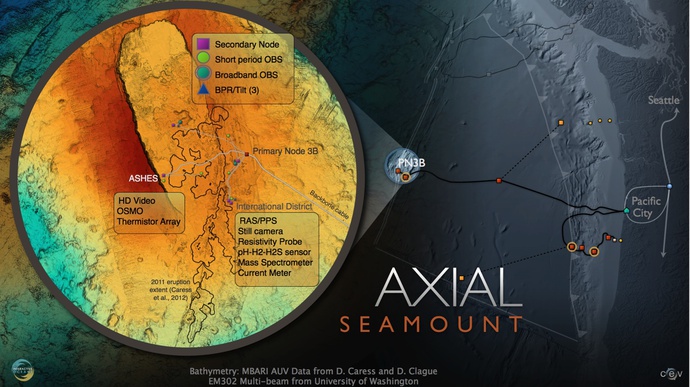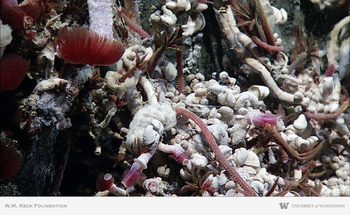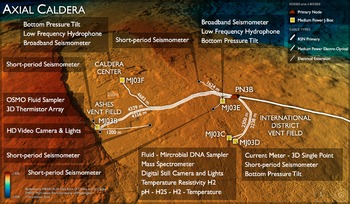Over 70% of the global volcanism occurs within the oceans.
Understanding Submarine Volcanoes
Two of the outstanding problems in marine sciences are understanding how submarine volcanoes support life in the absence of sunlight and the impact of perturbation events such as magmatic intrusion and earthquakes on geological, chemical and biological processes. Further advances in these studies are increasingly dependent on our ability to collect long-term, high-frequency observations using diverse networks of sensors and samplers. The major volcanic, magmatic and tectonic events that create the oceanic crust and modulate the fluxes of heat, chemicals and biological material across the seafloor and associated health of the biological communities are inherently episodic on decadal time scales and they are also short-lived. Transient events such as magmatic eruptions at mid-ocean ridges increase carbon dioxide output and venting volume by as much as a factor of 100, resulting in extensive microbial blooms.
A Cabled Observatory Now Installed at Axial Seamount
Axial Seamount is the most robust volcanic system on the Juan de Fuca Ridge and it is seismically, magmatically, and hydrothermally active. It is located on the Juan de Fuca spreading center ~300 miles offshore OR-WA and hosts three active hydrothermal fields (ASHES, CASM, and International District). This volcano is one of the best-studied volcanoes along the global mid-ocean ridge.
As part of NSF's Ocean Observatories Initiative, high bandwidth (10 Gb/s) and high power (8 kw) cables are now installed at the summit of Axial Volcano. These cables provide communication and power to a diverse array of 20 sensors. The instruments are actively monitoring inflation and deflation of the volcano during injection of magma and volcanic eruptions, hydrothermal activity, and the rich biological communities at this site. Real-time high definition video will provide unprecedented views of the tubeworms, crabs, and other animals at the vents. Other sensors now installed include an situ mass spectrometer, seismometers to monitor earthquake activity, temperature and chemical probes in boiling vent fluids, fluid and DNA samplers, and pressure-tilt meters. This is the largest single experiment in the global ocean focused on long-term measurements of underwater volcanoes.
Real-time data flow from seismometers on the volcano detected ~ 8000 earthquakes on April 24, 2015 marking the start of a seafloor eruption. This was accompanied by a drop in the seafloor of ~ 7 ft. Scientists and the public were able to watch this event unfold live because of the connection to the Internet from over 300 miles offshore.




